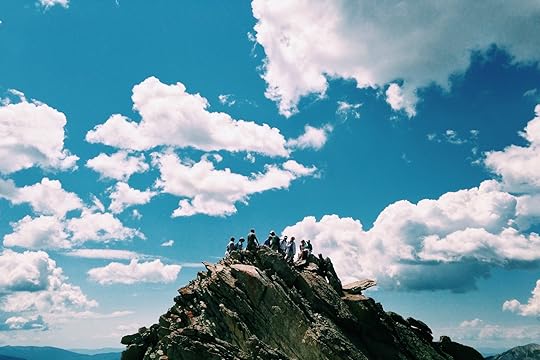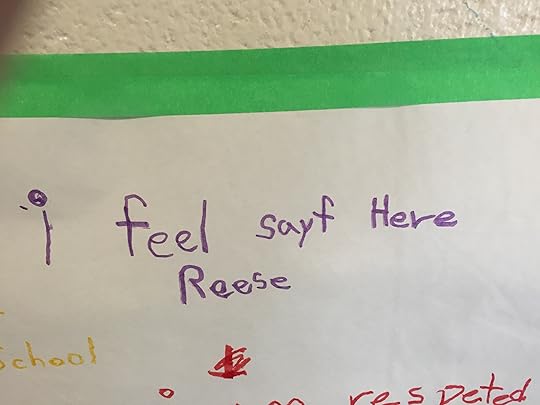How to Create a Space to Try Something New
 Training For Teachers – Taking The First Step
Training For Teachers – Taking The First Step
When I started teaching slam poetry in schools I hadn’t written any subject appropriate material for elementary age students. I remember one assembly slamming a piece about ‘ecumenical economics and the inequitable distribution of wealth’ and looking out at all these confused little kids and thinking to myself, “Rik…seriously, you’ve got to write some new material ASAP!” Haha…so I did. I wrote a slam specifically for those little dudes about trying to decide what I wanted to eat for breakfast every morning…cereal or toast. I called the poem, Cereal Monster.
It’s a goofy little slam (and going off audience response, really resonates with the 5-8 year-old crowd) Anyway…in this one class a little boy put up his hand and said, “Mr. Wick, you shouldn’t call it, ‘Cereal Monster’ you should call it, ‘Cereal Killer.’ Guys…seriously, that is THE BEST slam title ever! But could you imagine if I walked into your class and said, “hey boys and girls, would you like to hear a poem called ‘Serial Killer’…haha. You’d send me straight to the principal’s office before I could say another word.
Why We Desperately Need To Create A Safe Place
Jerry Seinfeld told a joke a few years ago about a study that said people’s number one fear was speaking in public. Number two was dying. His punch line was that at a funeral, more people would rather be in the casket than giving the eulogy. So where would that put slam poetry on the fear scale?
When I started working as a producer, I learned very quickly that everyone needs a safe place to take a creative risk. This is as true for young slam poets in a classroom as it is for musicians in a studio or actors on set. So if you want students your students take a creative risk and write and perform slam poetry (especially for the first time) you need to create a safe place for that to happen.
This is How I Create A Safe Place
I start my first session by getting students to help me create word banks of metaphors and similes. (most of the time I just call them expressions) I start by calling out a line and ask the students to fill in the blank, and then write their answers on the white board.
“Has anyone ever heard the expression, life is like a box of…”
Someone will yell, “chocolates!”
“How about, your room looks like a…”
“Disaster zone/tornado/bomb went off,” are typical answers.
“He’s as cute as a…kitten, button, puppy.”
I want to fill the room with voices, because it generates a creative energy that draws everyone into the process whether they’re calling out answers or not. After we have developed word banks of at least 5 metaphors and 5 similes, (feel free to write more) I ask students to write 2 lines each.
I give them a lead into their first line, “your words hurt like…” and I ask them to use a metaphor or simile to describe words that have hurt them. Their second line starts with, “your words are beautiful like…” and again I ask them to use a metaphor or simile.
When they start handing their papers in, I’ll get lines like,
“your words are like grizzly claws and teeth that tear me apart like a serrated blade”
“your words feel like Lego under my bare feet”
“your words are as beautiful a sunset that takes my breath away”
“your words feel like Advil with the power to heal”
Success is When We’ve Created a Safe Place To Try Something New
We don’t spend a lot of time, maybe five minutes. As soon as they’re done I get them to pass their papers into me, and I compile their lines into one group poem on the board at the front of class. Then I slam it for them. This session is all about creating a safe place for students to try something new. By passing their paper in to me, there is the safety of anonymity, cause no one knows which line they wrote. Giving them some common word banks and lead lines provides just enough structure that the exercise flows easily when I go to put their lines together.
I created this lesson to introduce the idea of slam poetry while providing a safe place to take the first step. I also designed it to show how our individuality and creativity is not in competition with those around us. What invariably happens is students realize their writing is just as good as anyone else and they go away knowing that they can do it. This is the first video lesson in my online course, and I’ve made it available for free. You are welcome to CHECK IT OUT HERE.
Slam Poetry in Schools is a course I created for teachers. It comes with instructional videos for each lesson. Each lesson includes worksheets and learning objectives that you can download and print, along with ‘sample’ slam poetry performance videos. I provide everything you need to use slam poetry in your classroom. It is a collection of the best lessons I’ve developed and taught over the last decade that you will be able to use year after year, for just $99.95 One of the things that makes this slam poetry course so unique and valuable for educators is that it was created for students in schools.
I have to tell you a really sweet (and pretty hilarious) story about an elementary student who wanted to perform his poetry in front of the school so much, he pushed through stage fright and emotional breakdowns and actually threw up backstage. It seriously felt like some kind of rock and roll tabloid story you’d hear about Keith Richards at a Rolling Stones concert! Haha…I’ll tell you all about it next time.
I hope you and your students are having a great week!
 As a performer/producer, published author and slam poet, discovering the value of my own creative talents and abilities has allowed me to tour the world, and participate in some life changing projects with the United Nations and the Foreign Affairs Department of Canada.
As a performer/producer, published author and slam poet, discovering the value of my own creative talents and abilities has allowed me to tour the world, and participate in some life changing projects with the United Nations and the Foreign Affairs Department of Canada.
I’m the author of, Four Homeless Millionaires – How One Family Found Riches By Leaving Everything Behind, and the Creative Director for Tribe of One, an international collective of indigenous artists, musicians, dancers and slam poets.
Developing the Slam Poetry in Schools training course for teachers, is a passion project 10 years in the making.
I invite you to check out the Closed Facebook Group, The Teacher’s Toolbox. It’s an online community forum that provides creative resources to teachers.
The post How to Create a Space to Try Something New appeared first on Rik Leaf.



